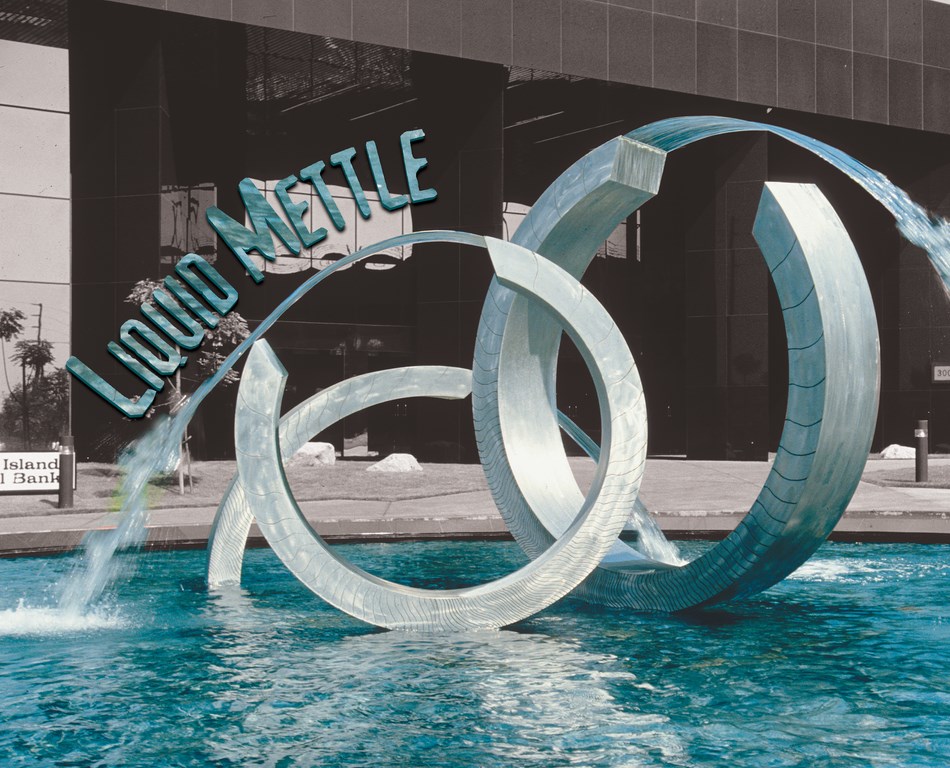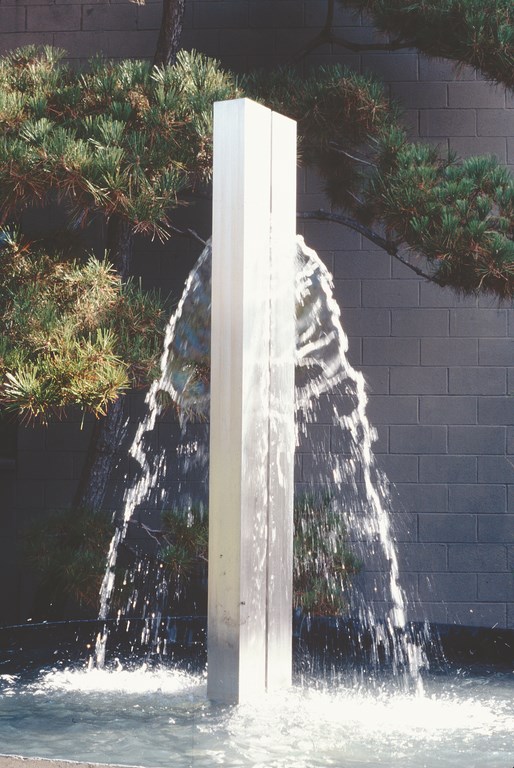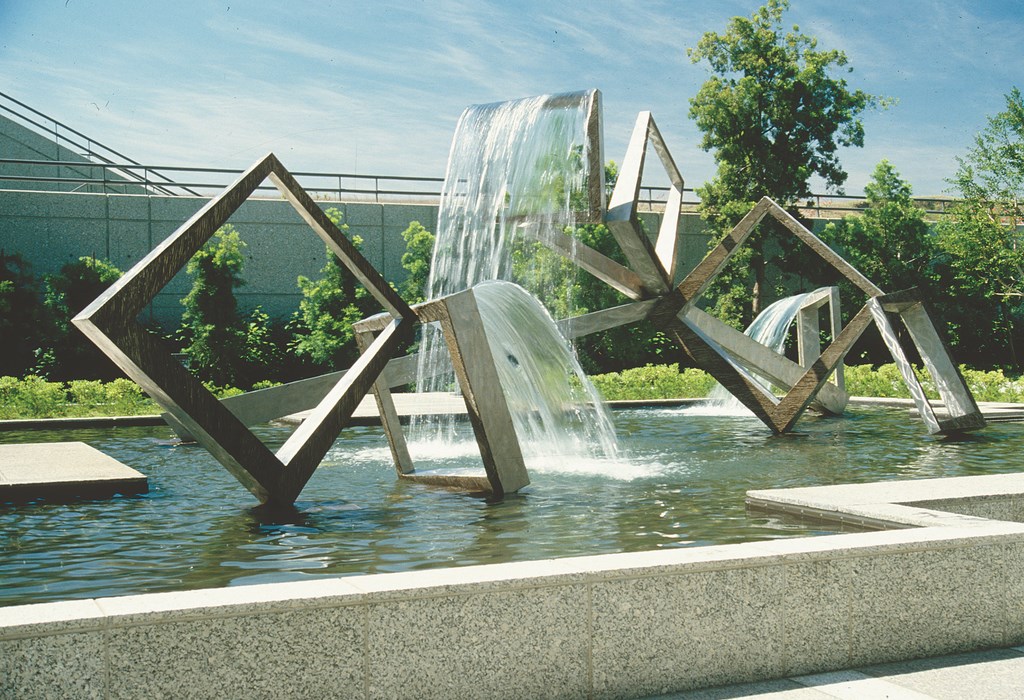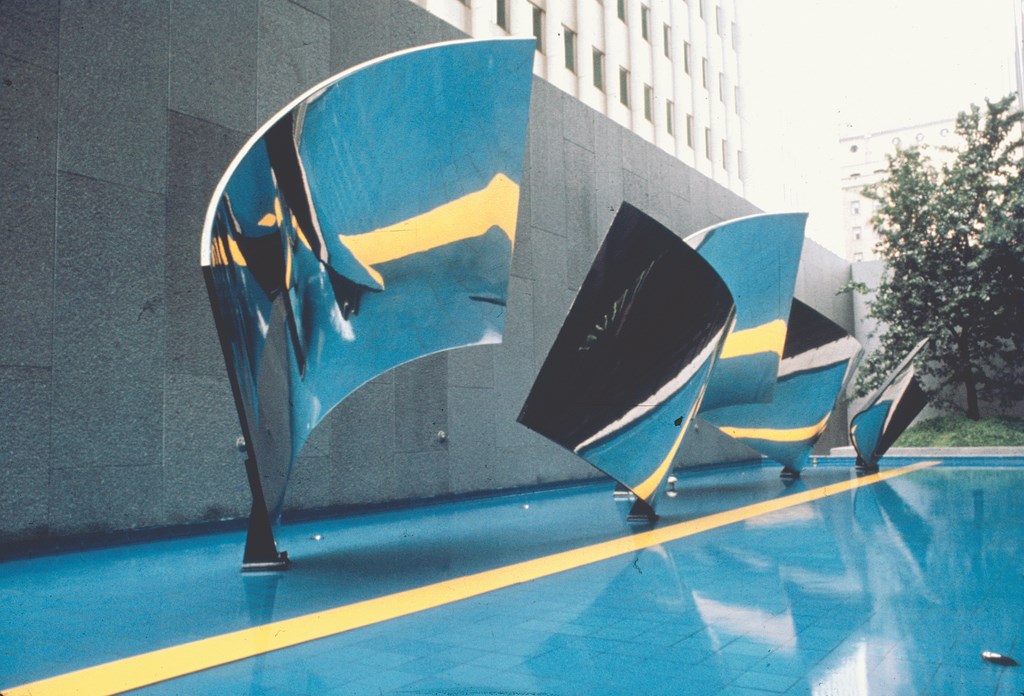Liquid Mettle

From the beginning of my career as a sculptor, I’ve mostly given myself over to two simple elements – metal and water – and have tried to develop approaches that turn one into an extension of the other.
I like the sense that a sheet of flowing water completes the simple stainless steel shapes I create. I also like to play with illusion by creating the impression that the water appears to come from nowhere. And I like getting involved in the hydraulics of laminar flow by making the water emerge from steel as a smooth, cohesive sheet.
In a sense, I draw constant inspiration from knowing that I could work with these two elements for my entire life and never come anywhere close to exhausting the creative ideas that await me.
AN ARTIST’S LIFE
As I see it, art really is a way of life for me. It definitely pays the bills, but it’s not a job and I rarely consider it to be work. I’ve been at it for more than 20 years now and have completed hundreds of projects from small to monumental, but I’m always surprised when I look at my list of commissions and see just how much I’ve done. Time really does go by when you’re having fun.
I was a Midwest transplant who moved to the West Coast at an early age, when my dad followed a business interest to Los Angeles. As a child, I spent hours playing with the backyard hose, making waterfalls and troughs and pools of water. As far back as I can remember, I’ve had this fixation with water. My dad, a mechanical engineer, encouraged me to work with tools and build things. This set an ideal foundation for my later interest in sculpting.
In high school, I developed keen interest in design and went on to study the graphic arts in college. Upon graduation, I was hired by North American Aviation to work as a graphic artist in their security sector and subsequently worked as an art director for a variety of graphic-arts firms in the Los Angeles area.
It was during this time that I became interested in sculpting and started with metal wall sculptures of various sizes. These early works were well received, and several commissions followed. Before long – and in what seemed a completely natural progression – I started indulging my childhood affinity for water by incorporating it in my work.
To house my many large projects, I built a three-story studio in North Hollywood, where many of my monumental sculptures have since been created. I have three 30-foot chain hoists in the main studio that enable workers to move the large metal pieces.
I do all the design work myself, and a handpicked staff assists me in fabricating my sculptures. I also work with my clients and an engineering firm on various technical specifications, such as the size of the pools that will contain my sculptures as well as their placement and hydraulics.
All pieces are pre-assembled at the studio and evaluated in a 13-foot-diameter test pool before being shipped to the job site. The test pool is also used to set up functioning models and prototypes of new designs.
COMPANION PIECES
This isn’t the kind of activity that lets you keep regular hours: I’ve been known to wake up in the middle of the night and go to work on a new idea.
Through all those long days and nights, I’ve never grown tired of finding new ways to combine stainless steel and water. They work well together in so many ways, and I’ve spent countless hours working, for example, on details of designs that use arcing sheets of water that visually defy gravity.
There’s much to be done to get these effects to behave the way I want them to, and the same goes for the visual effects I create for all sorts of designs in which my basic goal is to make these contrasting elements of water and steel appear as though they’re suspended in space.
In many of my designs, the sheeting water picks up the line of the stainless steel and completes the shape. Visually and metaphorically speaking, the water becomes the steel just as the steel becomes the water. In other situations, however, the water might simply trickle over the steel surface – or spray wildly into the air. I’ve also done pieces where the work sits above a reflecting pool of perfectly still water.
I’m passionate and playful with steel as well. Just as water has differing reflective qualities depending on how I manipulate its flow and surface textures, for example, stainless steel can be finished to a variety of reflective looks. I’ve done highly polished pieces that have a mirror surface, while on other projects I’ll etch, score or even tarnish the surface to create a variety of textures. I also enjoy creating effects where reflections seem to follow viewers as they move around a piece – a house-of-mirrors effect.
The malleability of these two materials and the capability I’ve developed through the years of working with them as extensions of one another have led me down some amazing pathways. As I’ve explored some of these avenues, I’ve learned to appreciate the fact that stainless steel resists corrosion and holds up well over time, even in the presence of chlorinated water or the occasional vandal or prankster.
TO THE POINT
I’ve never been one to intellectualize what I do: I just do it.
Most of the time, the ideas for the designs just come to me in ways that are still a mystery to me. When they emerge, I get excited about allowing an idea to lead in me in a certain direction. I’ve also enjoyed developing my personal design vocabulary and like to improvise around familiar visual ideas in different ways. My crescents, for example, are a distinct trademark of my early work and can be found in several pieces.
More than anything, though, I’d say I enjoy the design process – and especially love trying new ideas. Still, there’s a lot to be said for seeing the finished product in place and watching people enjoy it!
Crescents
The pieces pictured here (and at the start of this article) are among dozens of sculptures in which I’ve explored combinations of stainless steel crescents and arcing sheets of water. These are still among the most popular of my designs, and to this day many prospective clients say they want some sort of variation on this theme.
It was in designing these pieces that I really got the hang of working with laminar flow. In other sculptures I’ve seen, sheeting water usually breaks apart at about three feet out. By balancing the length and width of the nozzle’s opening with the flow and pressure of the water, I’ve been able to create sheets that hold together up to ten feet. (All photos courtesy and artworks copyright by Rafe Affleck. All rights reserved)
Windows in Space
For this project, set in the plaza in front of an aerospace company, I used the architecture of the adjacent building to inspire the design. The square windows appear to be tumbling through space, an effect accentuated by the flow of the water.
I’d say that more of my work draws inspiration from nature than from surrounding architecture: I’m a big fan of Japanese art and have a deep appreciation for its devotion to simple, minimalist forms. But in this case, these window forms made sense.
Simple Elegance
I’m often surprised and frequently amused by what art critics and other observers say about my work in their drive to find meaning where none is intended – and this is one of those pieces over which you could probably go crazy trying to affix some interpretation to it. 
The truth of the matter is that I designed this because I thought that a simple steel column with a dual-action crevice would be visually interesting – no more, no less. The fact that it works well against the landscaping of a private residence is also nice.
Earth Science
This piece was built for a wealthy couple in Rancho Santa Fe, Calif. In this case, there is some obvious symbolism, and lots of people who have seen the piece find specific California references in its etching and cracks and other “seismic” qualities. It’s all there in plain view.

 Also of interest is the unusual use here of the low, grass-covered knoll as a key design element.
Also of interest is the unusual use here of the low, grass-covered knoll as a key design element.
Compounded Reflections
As I mentioned in the accompanying text, I often enjoy playing with the reflective qualities of both steel and water. In this case, the mirror finishes on the bent panels definitely reflect the surrounding area and the water, especially the stark yellow line at the bottom of the pool.
What I like about this piece is that the reflective effects work both ways, with the water reflecting the panels and the images they capture just as brilliantly as the panels reflect the water and its features – a powerful, compelling and entertaining conjunction of liquid and metal.
Rafe Affleck is a North Hollywood, Calif.-based sculptor who creates modernistic and geometric stainless steel forms for fountains and watershapes. Most of his commissions come from commercial developers, but he also works for a range of very-high-end residential clients. Affleck’s career began more than 20 years ago, following a stint as a graphic designer for a variety of firms in the Southern California area. His portfolio includes hundreds of commissions for a worldwide register of clients.














